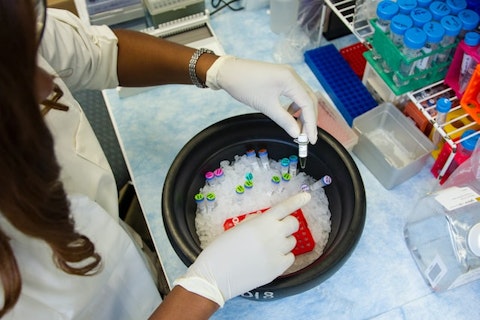Arbutus Biopharma Corporation (NASDAQ:ABUS) Q4 2022 Earnings Call Transcript March 2, 2023
Operator: Good day, and thank you for standing by. Welcome to the Arbutus Biopharma Corporation Fourth Quarter and Year-End 2022 Financial Results and Corporate Update Conference Call. At this time all participants are in a listen-only mode. After the speakers presentation there’ll be a question-and-answer session. . Please be advised today’s conference is being recorded. I would now like to hand the conference over to your speaker today, Lisa Caperelli. Please go ahead.
Lisa Caperelli: Thank you, Kevin. Good morning, everyone, and thank you for joining Arbutus’ Fourth Quarter and Year-end 2022 Financial Results and Corporate Update Call. Joining me today from the Arbutus Executive team are Bill Collier, President and Chief Executive Officer; David Hastings, Chief Financial Officer; and Dr. Mike Sofia, Chief Scientific Officer. Bill will begin with a corporate update, followed by Dr. Sofia who will provide an overview of our newly nominated coronavirus compound AB-343. Dave Hastings will then provide a review of the company’s fourth quarter and year-end 2022 financial results. After our prepared remarks, we will open the call for Q&A. Before we begin, I’d like to remind you that some of the statements made during the call today are forward-looking statements, which are subject to a number of risks and uncertainties that may cause our actual results to differ materially, including those described in our annual report on Form 10-K to be filed later today and from time to time in our other documents filed with the SEC.
With that, I’ll turn the call over to Bill Collier. Bill?
William Collier: Thank you, Lisa. Good morning, everyone, and thank you for joining us today. We appreciate your continued interest and support of Arbutus Biopharma. This morning, we issued a press release with our fourth quarter and year-end 2022 financials, as well as an update on the significant progress we made last year in advancing our proprietary compounds, moving us closer to our goals of potentially achieving a functional cure for chronic HBV as well as a novel and superior treatment for corona. We also highlighted our anticipated milestones for 2023, which include: Announcing AB-729 data from our two ongoing Phase IIa combination trials; and additional off-treatment data from our Phase Ib clinical trial. We also intend to initiate in 2023 three Phase I clinical trials with our early-stage compounds, namely: AB-101, our oral PD-L1 inhibitor; AB-161, our oral RNA destabilizer; and AB-343, our newly nominated nsp5 main protease inhibitor in development for coronavirus infection.
Suffice it to say, 2023 will be a busy year for us with potentially four compounds in the clinic by the end of the year. With respect to our mission to achieve a functional cure for patients with chronic HBV, we believe it’s necessary to suppress HBV DNA, reduce surface antigen and boost the immune system. And data that we generated last year from our Phase Ib clinical trial tells us that AB-729 can potentially achieve all three of these goals. This sets AB-729 up from other RNAi therapeutics in development. First, AB-729 has shown reawakening of HBV-specific community as well as a decrease in exhausted T-cells in some patients. In addition, a small subset of patients who met eligibility requirements to discontinue all HBV therapies following AB-729 treatment were able to control their HBV biomarkers, while off treatment.
Surface antigen levels in those patients remained well below pre-trial levels. Furthermore, their HBV DNA remains low, suggesting establishment of host immune control. Now these data reinforce our belief that AB-729 is one of the most advanced RNAi therapeutics in development and that it has the potential to be a cornerstone therapeutic in the treatment regimen for chronic HBV. Which leads me to our two ongoing Phase IIa clinical trials with AB-729, one in combination with Interferon and one in combination with Vaccitech’s therapeutic vaccine, VTP-300. At the end of 2022, we completed enrolment and announced preliminary data from the lead-in phase of AB-729-201, the Phase IIa clinical trial with 729 in combination with ongoing nucleoside analog therapy and short courses of interferon.
The first 15 patients who reached week 16 of treatment after receiving two doses of AB-729 on day 1 and week 8, plus NUC therapy, showed a mean surface antigen decline of 1.5 logs, which is comparable to the decline observed at the same time point in our Phase Ib clinical trial. These preliminary data further validates AB-729’s capacity to reduce surface antigen. As patients complete the lead insight, they are being randomized to receive interferon plus NUC therapy, plus or minus additional 729 doses for either 12 or 24 weeks. And we expect to have preliminary data from some of these patients who have received interferon in the first half of 2023. Our second Phase IIa clinical trial, AB-729-202, which is evaluating 729 NUC therapy and VTP-300 or placebo, is being expanded to include an additional arm with low-dose nivolumab, which is a PD-1 monoclonal antibody inhibitor that’s approved for a number of types of cancer under the brand name Opdivo.
We are adding nivolumab, more commonly known as nivo, to determine if the addition of nivo to the VTP-300 combination will further stimulate immune-mediated reduction of surface antigen after the initial treatment with 729. This amendment is currently under regulatory review. On regulatory approval, we intend to enrol 20 patients on ongoing NUC therapy who will receive 60 milligrams 729 every 8 weeks for 24 weeks, followed by VTP-300 plus a low dose of nivolumab. The Nivo dose that we will use is 1/10 the dose approved for oncology indications, which we believe to be a safe, yet efficacious. Patients who will remain on their NUC therapy during the 48 weeks of dosing with 729, VTP-300 and Nivo. Like all our trials, we will follow patients for 24 to 48 weeks after completion of the treatment period.

Photo by National Cancer Institute on Unsplash
As a reminder, dosing in this amended portion of the trial is expected to commence in the first half of 2023, and preliminary data from the original portion of the clinical trial, that is those patients who received 729 NUC and VTP-300 or placebo, is expected in the second half of 2023. To round out our HBV assets, last year we nominated and conducted IND-enabling studies with AB-101 as our oral PD-L1 inhibitor and with AB-161 as our oral RNA destabilizer. Both of these programs could play a role in developing a proprietary oral combination therapy to provide a functional care for patients with chronic HBV. We are on track to initiate Phase I clinical trials with each of these compounds, and we expect to report initial data this year. We’ll share more details when each of these trials commences.
Finally, as Dave will reiterate in a moment, we are in a strong financial position, with cash runway into Q4 of 2024. I’ll now ask Mike Sofia to review our progress in the . Over to you, Mike.
Michael Sofia: Thanks, Bill. Good morning, everyone. For the past year, the Arbutus research team has relentlessly focused on identifying and developing new antiviral small molecules to treat COVID-19 and future coronavirus outbreaks. Many question whether there would be a need for new or more therapeutics for coronaviruses, and I believe we can all say that the need exists as the virus continues to mutate, spread and reinfect. Our strategy focuses on targeting two essential enzymes critical for bio-replication and that are highly conserved across all known coronaviruses. These two targets are the SARS-CoV-2 nsp5 main proteases, also known as EMPro; and the nsp12 viral polymerase. We plan to identify compounds that target each of these essential enzymes, develop those compounds and ultimately combine them to pursue an optimized treatment regimen that is safe, effective, convenient and able to address current and future coronavirus strains.
Through our research efforts, we have discovered and nominated AB-343, an mPRO inhibitor, as our lead oral coronavirus drug candidate. We selected AB-343 based on its preclinical activity, safety profile and the potential for convenient dosing. From an activity standpoint, AB-343 is highly potent, with an IC50 against the enzyme in single-digit nanomolar and has equal potency against all known SARS-CoV-2 variants and robust activity against known mPRO-resistant variants. With respect to safety, AB-343 is highly selective for coronavirus mPRO versus human proteases. It also has a clean, broad cellular toxicity profile and off-target assessment profile. These characteristics support the reduced potential for unwanted side effects, thus further supporting candidate nomination and justification for progression into development.
Equally important to developing a drug that is safe and efficacious is to ensure that the drug is convenient for patients and physicians. Based on the preclinical PK data, AB-343 does not require enhancing with ritonavir boosting. This could lead to decreased pill burden and reduce potential for drug-drug interactions seen with ritonavir-boosted regimens. I’m impressed with AB-343’s preclinical profile and excited to move it forward into IND-enabling studies with the intent of initiating a Phase I clinical trial in the second half of this year. As I mentioned in my opening remarks, we are targeting two essential enzymes, the second one being nsp12 viral polymerase. Our research team is closing in on its efforts to identify a lead candidate we can then take into IND-enabling studies in the second half of this year.
We will provide an update when that compound has been identified and nominated. I will now turn the call over to Dave Hastings for a brief financial update. Dave?
David Hastings: Thanks, Mike, and good morning, everybody. As I’ve mentioned in the past, our key financial metrics are cash and financial runway. Our cash, cash equivalents and investments were approximately $184 million as of December 31, 2022, as compared to approximately $191 million as of December 31, 2021. During the year ended December 31, 2022, the company received a $40 million upfront payment from Qilu Pharmaceutical Company related to a technology transfer and license agreement for AB-729 in Greater China; $15 million of gross proceeds from Qilu’s equity investment in the company; and approximately $20 million of net proceeds from the issuance of common shares under Arbutus’ at-the-market offering program. These cash inflows were partially offset by approximately $79 million of cash used in operations.
The company expects a net cash burn of between $95 million to $100 million in 2023, and believes its cash runway will be sufficient to fund operations into the fourth quarter of 2024. Additionally, we were pleased to see that OMERS, who we sold our primary royalty interest in ONPATTRO to, now has earned $18.9 million in cumulative royalties. Now as a reminder, once OMERS collects $30 million in ONPATTRO royalties, that entitlement will revert back to us. After that reversion, our royalty rate is tiered, with the top tier being slightly over 3% for annual net sales greater than $500 million. So in closing, we are well positioned financially to advance our mission to develop a functional cure for HBV and a treatment for COVID-19 in potential future coronavirus outbreaks.
With that, I’ll turn the call back to Bill.
William Collier: Thanks, Dave. Before our Q&A session, I want to just to quickly remind everyone of the key milestones that we anticipate for 2023, and they are as follows. We plan to report initial data from the Phase IIa clinical trial combining 729 NUC therapy and VTP-300 in the second half of 2023, and to dose the first patient with Nivo in the clinical trial amendment that combines AB-729 VTP-300 plus Nivo. We also plan to announce preliminary interferon data from patients in the AB-729-201 clinical trial who received 729 plus therapy plus interferon. We plan to announce additional off-treatment data from our AB-729 Phase Ib trial. We plan on reporting initial data from the healthy volunteer single-dose portions of our Phase I clinical trials for AB-101 and AB-161.
And finally, we plan to initiate a Phase I clinical trial for AB-343, our mPRO coronavirus clinical candidate. And we look forward to providing you with updates as we progress our clinical development and achieve these milestones. So operator, we’re now ready for our Q&A session. Over to you.
See also 10 High Growth Low Dividend Stocks to Buy and 12 High Growth Financial Stocks to Buy.
Q&A Session
Follow Arbutus Biopharma Corp (NASDAQ:ABUS)
Follow Arbutus Biopharma Corp (NASDAQ:ABUS)
Operator: Our first question comes from Dennis Ding with Jefferies. Your line is open.
Dennis Ding: Thanks for taking the questions. Two for me. In terms of your corporate strategy this year, maybe comment on what your priorities are and how to balance your pipeline versus finding some BD opportunities with your broad pipeline? And then my second question is just around when you talk with potential partners in this space for Hep B, generally speaking, what level of clinical risk do you think partners would be comfortable with? And what do you think they would want to see before potentially advancing discussions with you? Thank you.
William Collier: Thank you, Dennis. Let me take the first part of the question, and then I think Mike Mc is on the line, and he can take the second piece. So we believe, actually, we’ve made a number of adjustments in our strategy in the last year or so in order to focus in on HBV and coronavirus. And that indeed makes — that includes making some pretty tough decisions. So you’ll notice today, we’ve said nothing about capsid inhibitors going forward. So that’s an illustration that we believe we have a very good compound in 729, we’re confident in moving 161 and 101 into the clinic, which could round out a very nice HBV portfolio. And as Mike just described, spending some of our resources on coronavirus, we believe, is still very relevant given the ongoing epidemic and pandemic around the world.
And we’ve been able to do all of that whilst extending our cash runway out to the end of 2024. So we feel like we have made some tough choices and prioritized appropriately, but still maintaining a real tight focus on our vision in trying to find a functional cure for HBV and an effective treatment for coronavirus. Mike, are you okay taking the second part of the question?
Michael McElhaugh: I am. So this was the one that is related to what level of clinical risk is relevant?
Lisa Caperelli: Yes.
Michael McElhaugh: Correct, Bill?
William Collier: .
Michael McElhaugh: Yes. So Dennis, thanks for the question. As we’ve discussed in the past, we have conversations with everybody in the field frequently, at all the — any conference that we’re at, where there’s people. I reach out to people all the time in regards to the BD work that needs to be done. So I’m always having conversations with people. As far as what level of clinical risk is sort of their guideline, they don’t really tell me that. I think it’s variable depending on who you’re speaking to, whether you’re speaking to a large company or a small company. And I think we just have to let the data evolve and see how those conversations progress. But we’ll continue to have those conversations.
Dennis Ding: Got it. Thank you.
Operator: Our next question comes from Brian Skorney with Baird. Your line is open.
Charles Moore: Good morning, guys. This is Charlie on for Brian. So I was curious if there’s anything we can look for beyond safety to get a good grasp on potential activity for either the oral PD-L1 or the RNA destabilizer? As well as looking at 729 with one of the patients becoming eligible to restart new therapies. We’re just curious what kind of proportion would you be looking here for the remaining patients in terms of defining success for you guys? Thank you.



